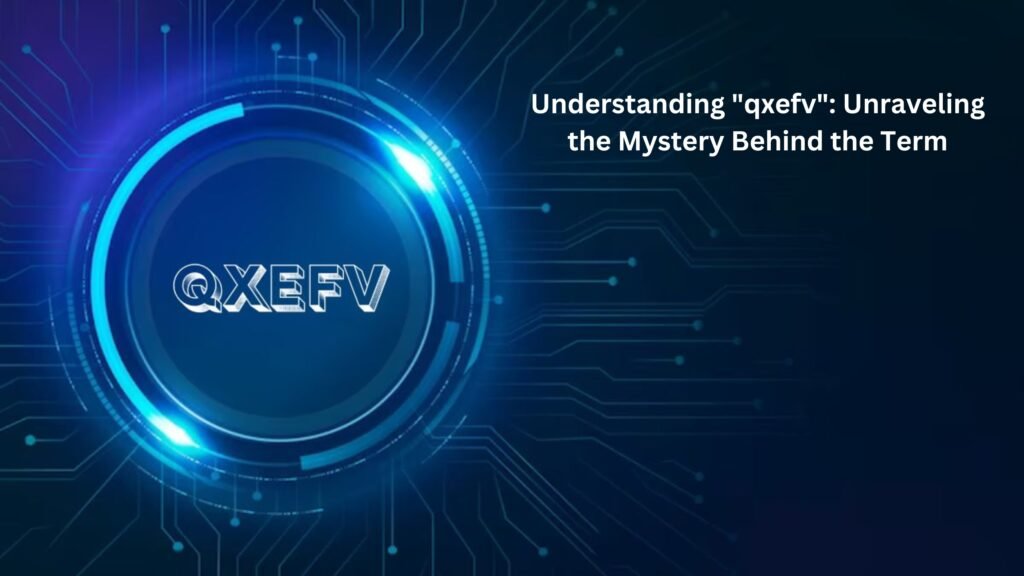In the vast and ever-evolving world of the internet, new terms, acronyms, and strings of characters often surface, capturing our curiosity. One such enigmatic term that has recently caught attention is “qxefv.” At first glance, it appears to be a random sequence of letters. However, its ambiguity prompts a deeper exploration into its potential meanings, origins, and uses. This article aims to demystify “qxefv” by examining various possibilities and contexts in which it might be used.
The Nature of Random Strings
Random strings like “qxefv” are common in the digital landscape. They often appear in various contexts, from usernames and passwords to coded messages and technical identifiers. Let’s explore some plausible scenarios for the existence of “qxefv.”

1. Typographical Error or Random Generation
One straightforward explanation is that “qxefv” is a typographical error or a product of random character generation. Random strings are frequently used in computing for purposes like:
- Password Generation: Creating strong, unpredictable passwords.
- Coding and Programming: Placeholder text or unique identifiers in software development.
- Testing: Input data for testing the robustness of systems and applications.
2. Unique Username or Handle
In the digital age, finding a unique username can be challenging due to the sheer number of users on platforms. “qxefv” could be a chosen username or handle designed to be unique and avoid duplication. This use is particularly common in:
- Social Media: Where users strive for distinctive identifiers.
- Gaming: Gamers often select unique names to stand out in the community.
- Online Forums: Participants choose unique handles to maintain anonymity or create a distinct online persona.
3. Acronym or Abbreviation
Although “qxefv” doesn’t correspond to any widely recognized acronym, it could represent an abbreviation for a phrase or concept known only to a specific group or individual. For instance, it might stand for:
- QXE Framework Version: In a tech context, it could refer to a specific version of a software framework.
- Quick Exchange File Vault: A hypothetical service or tool name.
4. Cryptographic Key or Code
In cybersecurity and encryption, seemingly random strings often serve as keys or codes. “qxefv” might be used in this capacity, such as:
- Encryption Keys: Random strings used to encrypt and decrypt data.
- Authentication Tokens: Unique codes that verify user identities or access permissions.
- Ciphers: Part of a coded message requiring decryption.
5. Niche or Insider Term
Sometimes, terms like “qxefv” develop within niche communities or among small groups as insider jargon. In such cases, the meaning might be clear only to those within the circle. This could apply to:
- Private Groups: Friends or colleagues using it as an inside joke or shorthand.
- Online Communities: Members of a specific forum or chat group adopting it for specific purposes.
Researching “qxefv”
To uncover more about “qxefv,” one can take several investigative steps:
1. Contextual Analysis
If “qxefv” appears in a message, post, or any specific context, examining the surrounding text can provide clues. Understanding the context helps in interpreting the intended meaning or use.
2. Search Engines and Online Databases
Performing a web search for “qxefv” might reveal if it is used elsewhere. It could appear in forums, social media posts, or specialized databases, giving insights into its application or origin.
3. Community Inquiries
Engaging with online communities, such as tech forums, social media groups, or cryptography enthusiasts, can yield explanations or hypotheses. Members of these communities might recognize the term or have ideas about its possible uses.
4. Linguistic Tools
Using linguistic and lexical tools can help determine if “qxefv” has any roots in known languages or if it follows any linguistic patterns. This might involve checking acronym databases or employing translation tools.
5. Cryptographic Analysis
If there’s a suspicion that “qxefv” is part of an encrypted message, cryptographic analysis tools can be used to attempt decryption. This process usually requires expertise in cryptography and appropriate software tools.
Hypothetical Scenarios Involving “qxefv”
To illustrate potential uses, here are some hypothetical scenarios where “qxefv” might appear:
Scenario 1: Secure Communication
In a secure communication system, “qxefv” might be an authentication token used to verify the identity of a user or device. For example, a secure messaging app could generate “qxefv” as a temporary code for a user session.
Scenario 2: Unique Product Code
A tech company develops a new software tool and designates “qxefv” as its unique product code. This code helps in tracking versions, updates, and user feedback related to the product.
Scenario 3: Online Alias
An individual chooses “qxefv” as their username on a new social media platform. The uniqueness of the string ensures that the name is available and easily recognizable in the digital space.
Scenario 4: Encrypted Message
In a cybersecurity exercise, “qxefv” might be used as part of an encrypted message. Decoding the message requires knowledge of the encryption method and key, making “qxefv” a critical component of the secure communication.
Conclusion
The term “qxefv” is a fascinating example of how random strings and seemingly meaningless sequences can capture curiosity and provoke investigation. While it may not have an immediately clear definition, its potential uses are vast, ranging from secure communication to unique online identifiers. Understanding such terms involves contextual analysis, research, and sometimes a bit of creative thinking. Whether “qxefv” is a random string, a cryptographic key, or a unique username, it highlights the dynamic and ever-changing nature of language and communication in the digital age.
